

Using Pinterest in the Classroom on Pinterest. 10 Ways to Use Pinterest in the Classroom. Due to the popularity of my post Pinterest – Turning Procrastination into Classroom Preparation, I’ve decided to follow up with ways to use Pinterest with students.
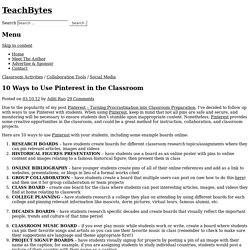
When using Pinterest, keep in mind that not all pins are safe and secure, and monitoring will be necessary to ensure students don’t stumble upon inappropriate content. Nonetheless, Pinterest provides some creative opportunities in the classroom, and could be a great method for instruction, collaboration, and classroom projects. Here are 10 ways to use Pinterest with your students, including some example boards online: CLASSROOM MUSIC BOARD – if you ever play music while students work or write, create a board where students can pin their favorite songs and artists so you can use their favorite music in class (remember to check to make sure their suggestions are language and theme appropriate first!)
37 Ways Teachers Can Use Pinterest In The Classroom. 37 Ways Teachers Can Use Pinterest In The Classroom There are a lot of great technology tools out there for teachers that can make it easier to connect with other educators, get ideas for classroom activities, and find inspiration.
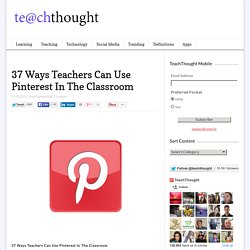
One of the newest and best of these online tools is Pinterest, which has quickly become a favorite among educators. Using online “pinboards” teachers can save everything from photos to blog posts in one easily accessible and usable place. Educators who are curious about Pinterest should sign up for an invitation today (it’s still invite only, but it doesn’t take long to get an invitation) and start creating their own amazing collections of pins. Not sure where to start? Pinterest is ideal for getting inspired on a wide range of topics. Elearn Magazine: Developing Engaging Content. eLearning allows one to learn on the fly, on their own schedule, and at their own pace.
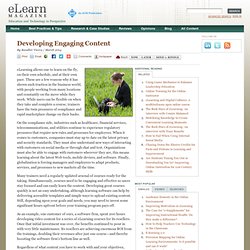
These are a few reasons why it has shown such traction in the business world, with people working from many locations and constantly on the move while they work. While users can be flexible on when they take and complete a course, trainers have the twin pressures of compliance and rapid marketplace change on their backs. On the compliance side, industries such as healthcare, financial services, telecommunications, and utilities continue to experience regulatory pressures that require new rules and processes for employees. When it comes to customers, companies must stay up to date on the latest privacy and security standards. They must also understand new ways of interacting with customers on social media or through chat and text. Many trainers need a regularly updated arsenal of courses ready for the taking. 1. 2. 3. 4. 5. 6. About the Author Randhir Vieira is VP of Product and Marketing at Mindflash.
Teaching with Digital Media in Writing Studies. Overview In Teaching with Digital Media in Writing Studies: An Exploration of Ethical Responsibilities, Toby Coley examines the ethical implications of composing with digital media, focusing on undergraduate composition courses.
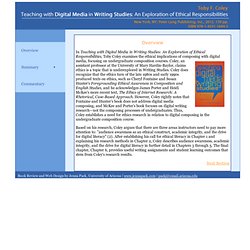
Coley, an assistant professor at the University of Mary Hardin-Baylor, claims ethics is a topic that is underexplored in Writing Studies. Coley does recognize that the ethics turn of the late 1980s and early 1990s produced texts on ethics, such as Cheryl Fontaine and Susan Hunter’s Foregrounding Ethical Awareness in Composition and English Studies, and he acknowledges James Porter and Heidi McKee’s more recent text, The Ethics of Internet Research: A Rhetorical, Case-Based Approach.
However, Coley rightly notes that Fontaine and Hunter’s book does not address digital media composing, and McKee and Porter’s book focuses on digital writing research—not the composing processes of undergraduates. Next Section. Time and Teaching Comp Online. 5 Tools for Building a Next-Generation ‘Hybrid’ Class Website – ProfHacker - Blogs. [Nicholas C.
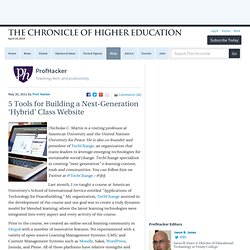
Martin is a visiting professor at American University and the United Nations University for Peace. He is also co-founder and president of TechChange, an organization that trains leaders to leverage emerging technologies for sustainable social change. TechChange specializes in creating “next-generation” e-learning content, tools and communities. You can follow him on Twitter at @TechChange. --@jbj] Last month, I co-taught a course at American University’s School of International Service entitled ”Applications of Technology for Peacebuilding.” Prior to the course, we created an online social learning community in Drupal with a number of innovative features. Once we got the Drupal site up and running we began creating and embedding various tools to support the learning process. If you’re interested in seeing some of these tools in action you can view a sample TechChange Unit. What We’re Working on Next: Photo provided by Nick Martin. Hybrid Courses: Faculty Resources.
Advantages New teaching opportunities: "The hybrid took something I always knew was possible and let me do it.

" Faculty can teach using a variety of online and in-class teaching strategies, which make it possible to achieve course goals and objectives more effectively. The hybrid model allows faculty to develop solutions to course problems and to incorporate new types of interactive and independent learning activities that were not possible in traditional courses. Student engagement: "In the online classroom, there is no place to hide….